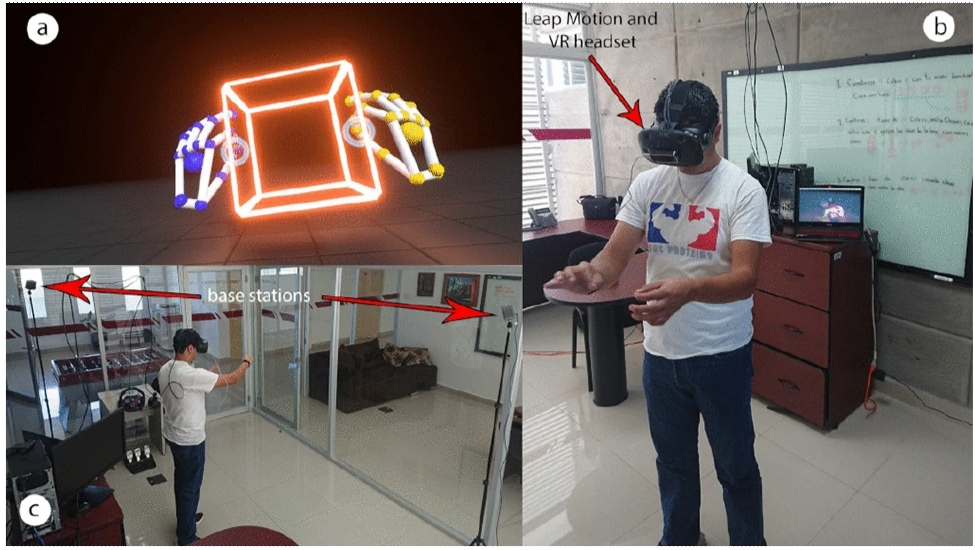
Developing a model to evaluate and improve user experience with hand motions in virtual reality environments (source)
Keywords: User Experience, Virtual Reality, Handedness, Engagement, Enjoyment
In video games, the evaluation of the user experience (UX) mainly refers to two main groups of aspects, those that refer to the player that is mainly oriented to make the player feel good while playing and those that refer to the video game that is oriented to make the video game easy to understand and play. The aspects considered that are related to the player are engagement, enjoyment, and flow; the aspects related to video game, usability, and dependability. Virtual reality environments today have changed the paradigm in various fields of application, such as health, education, entertainment, among others. Therefore, it is important to observe the effects of handedness with hand movements in virtual reality environments. work proposes a model to evaluate and improve the user experience considering player and video game aspects, taking into account handedness with hand movements in virtual reality environments. Player and video game aspects can be added to evaluations of the effect of handedness, especially in virtual reality environments, in order to know the user’s behavior in terms of skill, performance, and accuracy, among other features by using a particular hand to perform specific tasks. Next, a case study is presented with two groups of users using a virtual reality environment to perform several user tasks considering the dominant and non-dominant hand. By evaluating the user tasks it is possible to know the levels of engagement, enjoyment, motivation, and usability in a virtual reality environment. Finally, an analysis of results is presented in which several improvements of UX are presented.
Problem Outline
Literature work shows that player and game aspects in video games related to HCI, were remarkably diverse in the literature; these two aspects are described in the following subsections (see Figure below). Some of these works are focused on evaluating and improving the game experience without considering the fact that all users have different preferences and therefore, the satisfaction of each one has to be achieved in a different way.
Thus, it is necessary to design a model to adapt virtual reality environments to the preferences of the user; the scales that allow the evaluation of the aspects of player and video game have to be analyzed, therefore the following research questions are presented:
- - Do hand gestures have a significant effect on aspects of the player?
- - Do hand gestures in virtual reality environments have a significant effect on usability?
- - Does handedness have a significant effect on virtual reality tasks?

Proposed Model
There is a need for strategies that allow improving the user experience from a gaming perspective in a personal way and additionally consider aspects of handedness for virtual reality environments. In that respect, this work proposes an evaluation model that can support the improvement of user experience considering the factor handedness for virtual reality environments. The evaluation of the improvement of the user experience is achieved through the user-centered model proposed in figure above, analyzing user tasks (with or without the dominant hand) in several usability tests when users interact with virtual reality environments. The proposed model consists of three-stage described below. In the first stage, a survey is carried out with the participants about their personal data (age, gender, right or left-handed among others) as well as the degree of their experience interacting with virtual reality. The participants were distributed either in a dominant hand group or in the non-dominant hand group.
In the second stage, for each user task, usability tests are carried out considering the handedness for virtual reality environments. The user experience questionnaire UEQ scale is applied after each task. In the final stage, data is extracted on the evaluation of user aspects, as well as the duration and effort made by each task analyzed in the previous stage. The stage ends, in the statistical analysis on the improvement of the user experience. The proposed model leads us to consider the following challenges related to the evaluation of the user experience in virtual reality environments:
- - Consider aspects of player-video game interaction in the game scales
- - To have a model for evaluating the user experience from a personal perspective
- - Consider an evaluation of handedness for virtual reality environments
- - The rating scales are based on a large number of elements

Implementation Model
This section presents the implementation of the proposed model through a case study, where a set of tasks were developed by two groups: (a) the dominant group (participants who were required to use their dominant hand) and (b) the non-dominant group (participants who were required to use their non-dominant hand only). The following describes the implementation design in the context of the proposed model.
Participants
For this case study, we had the participation of 16 people belonging to our research institute (7 women, average age 25, SD = 3.9), 8 were selected to be considered as part of the dominant group and the other 8 for the group considered as non-dominant. It is worth mentioning that it was difficult to gather a larger number of participants because the COVID-19 pandemic was on the rise and health measures were being implemented at the institute, making it difficult for people to come to the institute and it was decided to invite a limited group of people close to them.
Materials
Various hardware and software elements were used for the development of this experiment. To select the VR environment, a heuristic evaluation of usability for games was selected, where the authors of the evaluation introduced a set of usability inspections in video games; from this, the environment was selected from the LeapMotionFootnote1 gallery (applications). These applications were considered appropriate because they are virtual reality environments that in their entirety the user must use their hands to interact. It is worth mentioning that these virtual reality environments are mostly demo versions, and were selected for their simplicity.
Table below, presents a total of 24 virtual reality environments from the LeapMotion gallery that were examined; all available in the gallery were analyzed though some of them presented compatibility problems or did not work properly.
| Video game | Consistency | Customizability | Predictability | Proper views | Skip content | Input mappings | Controls | Game status | Training and help | Visual repr. | Summary |
|---|---|---|---|---|---|---|---|---|---|---|---|
| Blocks | x | x | x | x | x | x | x | x | 8 | ||
| Particles | x | x | x | x | x | x | x | 7 | |||
| Cat explorer | x | x | x | x | x | x | 6 | ||||
| Mirrors | x | x | x | x | x | 5 | |||||
| Scaffolding | x | x | x | x | x | 5 | |||||
| VR visualizer | x | x | x | 3 | |||||||
| Hovercast VR | x | x | x | x | x | x | 6 | ||||
| Virtual Music 2 | x | x | x | x | x | x | 6 | ||||
| Rainbow Jelly AR | x | x | x | x | x | 5 | |||||
| UI Input module | x | x | x | x | x | x | x | 7 | |||
| Pinch Draw | x | x | x | x | x | x | x | x | 8 | ||
| Attachments module | x | x | x | x | 4 |
The hardware used to run Blocks consisted of an HTC Vive virtual reality system and a desktop computer with a GeForce RTX 2060 graphics card. In addition, the integration of the Leapmotion controller sensor into the virtual reality system to perform hand and finger movement interactions (soft control); this technology was selected because we believe it improves the perceived realism of common hard controls (e.g., joysticks, keyboard, and virtual reality controls).
For the evaluation of the player aspects, the Game User Experience Satisfaction Scale (GUESS) was selected, which covers all aspects of gamer-video game interaction. GUESS consists of 55 items with 9 scales: “playability”, “narratives”, “play engrossment”, “enjoyment”, “creative freedom”, “audio aesthetics”, “personal gratification”, “social connectivity”, and “visual aesthetics”. Due to the simplicity of the virtual reality environment, we ignore the scales of “audio aesthetics” and “social connectivity” because Blocks does not support those features.
Procedure
Participants were asked to voluntarily sign a consent form and were given a brief description of the study. Moreover, they were instructed and given a pre-screening questionnaire to capture information to generate a user profile. The participants entered the room where the virtual reality device is located, which makes up an area of 2.7m x 2.0m. In a first approach to the virtual reality environment, they were allowed to explore and interact with an avatar that acts as an assistant in an initial phase of training. Once the training phase was completed, they were asked to perform the following tasks:
- - Task 1: Pinch and release, create four cubes and with your hand stack them one by one until you create a tower.
- - Task 2: Levitation and hit, create a tower of four cubes, turn off gravity, create a tower of four cubes, turn off gravity, create a cube and with your hand push it towards the tower until it hits a tower cube, repeat the procedure until all four tower cubes have been hit.
- - Task 3: Finger pinch and release, create a tower of four cubes, generate a cube, and stack it, repeat the process until a tower of four cubes is formed
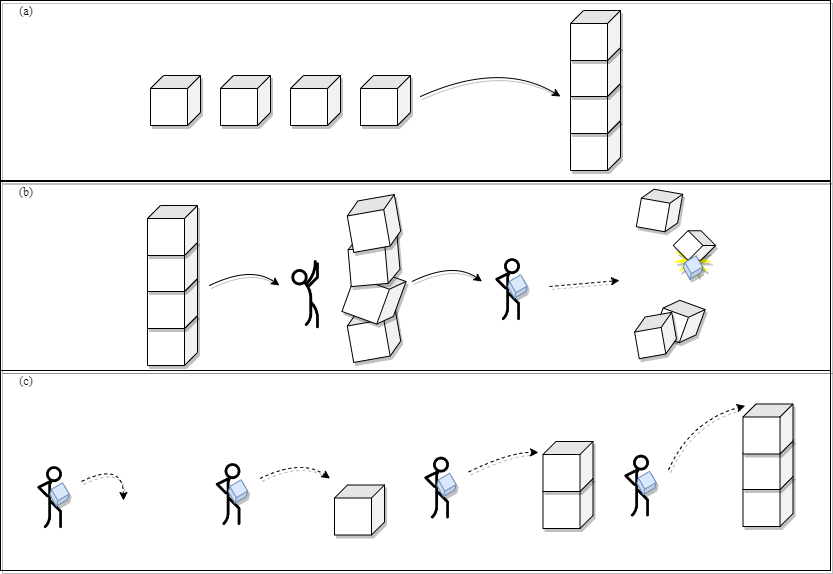
Design
Figure below, illustrates the interaction of the experiment from different perspectives. After each task, the perceived usability load was measured using the UEQ, which usually took one minute to respond. Once the three tasks were finished, participants completed the GUESS scale and gave preference scores (e.g., which of the tasks was the least and least preferred, which of the tasks was the least and most preferred, as well as comments on the interaction).

Results
This section presents the results from the information obtained from the experiment carried out in the previous section. An Analysis of Variance (ANOVA) was performed to evaluate the player, performance, and usability aspects of the tasks in the virtual reality environment. Since the purpose of the study does not to attempt to look for correlations between dependent variables, and the work is focused on a series of univariate hypotheses. According to Huberty it is appropriate to use a univariate analysis. The results of the GUESS scale, the data obtained in time and attempts of the tasks performed (Table below), and the results of the UEQ scale are also presented.
| Sub-scale | Dominant | Non-dominant | ||||||||||||||||||
|---|---|---|---|---|---|---|---|---|---|---|---|---|---|---|---|---|---|---|---|---|
| P2 | P3 | P5 | P6 | P7 | P8 | P9 | P10 | M | SD | P1 | P4 | P11 | P12 | P13 | P14 | P15 | P16 | M | SD | |
| Game absorption | ||||||||||||||||||||
| I feel detached from the outside world while playing | 6 | 4 | 5 | 6 | 5 | 3 | 5 | 6 | 5.00 | 1.07 | 7 | 1 | 6 | 4 | 7 | 6 | 7 | 7 | 5.63 | 2.13 |
| I don’t care about the events that occur in the real world during the game | 7 | 5 | 7 | 5 | 2 | 4 | 2 | 4 | 4.50 | 1.93 | 7 | 1 | 4 | 5 | 1 | 7 | 5 | 4 | 4.25 | 2.31 |
| I can’t tell I’m getting tired while playing the game | 6 | 4 | 5 | 7 | 4 | 2 | 2 | 5 | 4.38 | 1.77 | 4 | 4 | 5 | 6 | 7 | 5 | 6 | 5 | 5.25 | 1.04 |
| Sometimes I lost track of time while playing the game | 5 | 1 | 7 | 5 | 4 | 4 | 1 | 2 | 3.63 | 2.13 | 7 | 1 | 4 | 7 | 1 | 7 | 6 | 7 | 5.00 | 2.67 |
| I temporarily forget about my daily worries while playing the game | 6 | 6 | 6 | 7 | 2 | 5 | 3 | 7 | 5.25 | 1.83 | 7 | 1 | 6 | 7 | 7 | 7 | 7 | 5 | 5.88 | 2.10 |
| I tend to spend more time playing than I have planned for | 7 | 3 | 5 | 6 | 5 | 6 | 5 | 6 | 5.38 | 1.19 | 7 | 2 | 6 | 7 | 1 | 7 | 7 | 4 | 5.13 | 2.47 |
| I can block out most of the other distractions when playing games | 7 | 4 | 7 | 6 | 4 | 4 | 5 | 7 | 5.50 | 1.41 | 7 | 1 | 4 | 3 | 4 | 7 | 7 | 5 | 4.75 | 2.19 |
| Every time I stop playing the game, I can’t wait to play it again | 4 | 5 | 7 | 4 | 2 | 1 | 2 | 4 | 3.63 | 1.92 | 7 | 3 | 4 | 7 | 1 | 7 | 4 | 4 | 4.63 | 2.20 |
| Player enjoyment | ||||||||||||||||||||
| I think the game is fun | 7 | 7 | 7 | 7 | 5 | 7 | 7 | 7 | 6.75 | 0.71 | 7 | 6 | 7 | 7 | 7 | 7 | 7 | 6 | 6.75 | 0.46 |
| I enjoyed playing the game | 7 | 7 | 7 | 7 | 4 | 7 | 6 | 7 | 6.50 | 1.07 | 7 | 1 | 7 | 7 | 7 | 7 | 7 | 7 | 6.25 | 2.12 |
| I felt bored while playing | 1 | 1 | 3 | 1 | 4 | 2 | 2 | 2 | 2.00 | 1.07 | 1 | 7 | 2 | 2 | 1 | 1 | 1 | 1 | 2.00 | 2.07 |
| I am likely to recommend this game to others | 7 | 5 | 7 | 6 | 5 | 6 | 6 | 7 | 6.13 | 0.83 | 4 | 2 | 7 | 7 | 7 | 7 | 7 | 4 | 5.63 | 2.00 |
| If the opportunity exists, I would like to play it again | 7 | 5 | 7 | 7 | 4 | 6 | 4 | 7 | 5.88 | 1.36 | 7 | 1 | 7 | 7 | 7 | 7 | 7 | 6 | 6.13 | 2.10 |
| Personal gratification | ||||||||||||||||||||
| I am in suspense about whether I will succeed in the game | 6 | 4 | 6 | 4 | 6 | 3 | 2 | 2 | 7.00 | 0.00 | 6 | 7 | 6 | 4 | 5 | 7 | 6 | 4 | 5.50 | 1.71 |
| I feel successful when I overcome obstacles in the game | 7 | 7 | 7 | 7 | 4 | 5 | 4 | 6 | 6.17 | 0.90 | 7 | 7 | 7 | 7 | 7 | 7 | 7 | 7 | 6.33 | 0.75 |
| I want to do my best during the game | 7 | 5 | 7 | 6 | 5 | 6 | 6 | 7 | 6.00 | 1.00 | 7 | 7 | 7 | 6 | 7 | 7 | 3 | 7 | 5.67 | 1.60 |
| I am very focused on my own performance while playing the game | 7 | 2 | 5 | 6 | 4 | 4 | 6 | 5 | 4.33 | 0.94 | 7 | 7 | 6 | 3 | 7 | 7 | 7 | 7 | 6.17 | 1.21 |
| I feel that the game constantly motivates me to continue to the next levels | 5 | 4 | 5 | 6 | 3 | 5 | 3 | 7 | 4.67 | 0.94 | 4 | 7 | 7 | 7 | 4 | 7 | 7 | 5 | 6.83 | 0.37 |
| I think my skills gradually improve through the challenges in the game | 7 | 5 | 7 | 7 | 4 | 5 | 5 | 6 | 4.33 | 1.49 | 6 | 7 | 5 | 7 | 7 | 6 | 6 | 6 | 6.00 | 1.41 |
Effects of hand gestures on the player aspect
The second research question (RQ2) posed in Sect. 3 refers to whether hand gestures for interaction in virtual reality environments have a significant effect on usability. To answer this question, the results of the UEQ scale presented in Figure below were analyzed. Together, an ANOVA one-way between subjects was performed to compare the handedness gestures on usability.
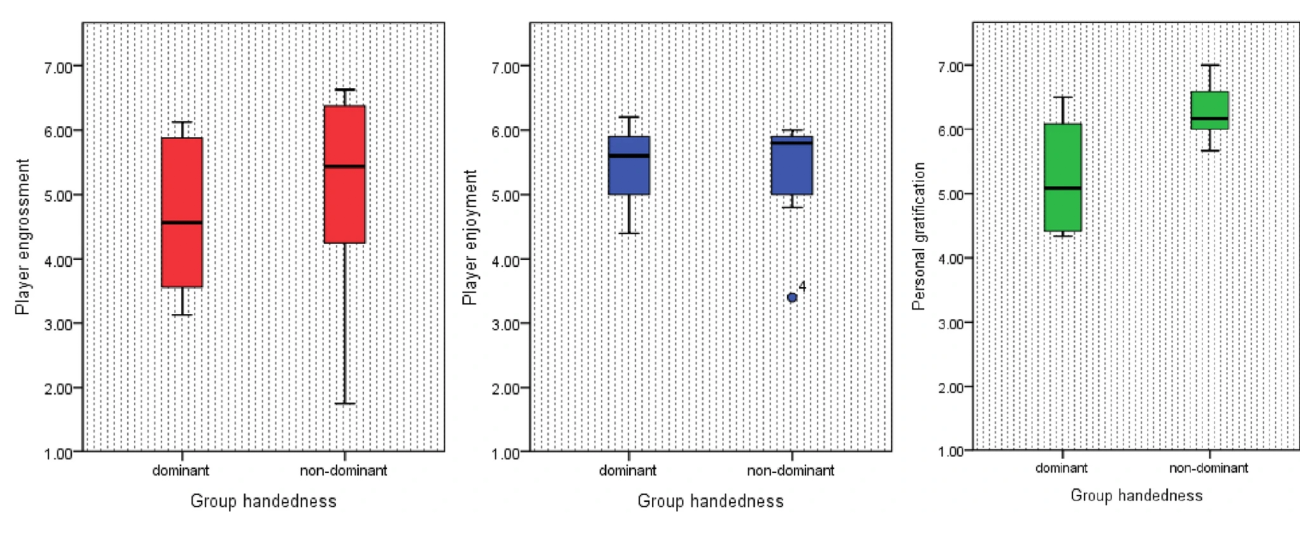
The results showed a non-significant effect of hand gestures on usability at the p<.05 level. Except for “efficiency” and “dependability”, all scales showed high values, this was due to the fact that the participants manifested to require a greater effort to complete the tasks, it is worth mentioning that none of them had experience in performing hand movements in virtual reality environments. Therefore, the participants, in general, got a great overall impression of the tasks, understandable, exciting and valuable as shown in Figure below.
Effects of hand gestures on usability
Next figure represents the user preferences process. First, the user enters a testing stage and chooses an option to acquire his preferences, said preferences can be obtained from the following options, Option 1: the user enters the test and, once in the test, selects the parameters he/she finds satisfactory. Option 2: the user enters the test and once it is completed, the user selects the preferred parameters.
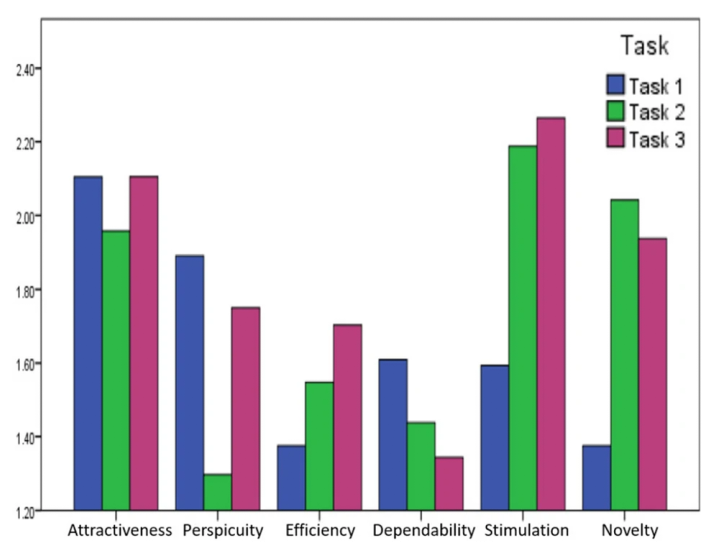
Effects of handedness on VR tasks
To address the issue raised in RQ3, i.e whether handedness has a significant effect on virtual reality tasks—time and attempts—an ANOVA was conducted between the two groups of participants.
As can be seen in Figure below, a significant effect of handedness was shown in the Task 1 attempts with p<.10 (F1,14=3.45, p=.084). In the attempts of Task 2 (F1,14=0.503, ns) and Task 3 (F1,14=0.052, ns) no significant effect was shown. The recorded times for Task 1 (F1,14=0.037, ns), Task 2 (F1,14=0.416, ns) and Task 3 (F1,14=0.907, ns).
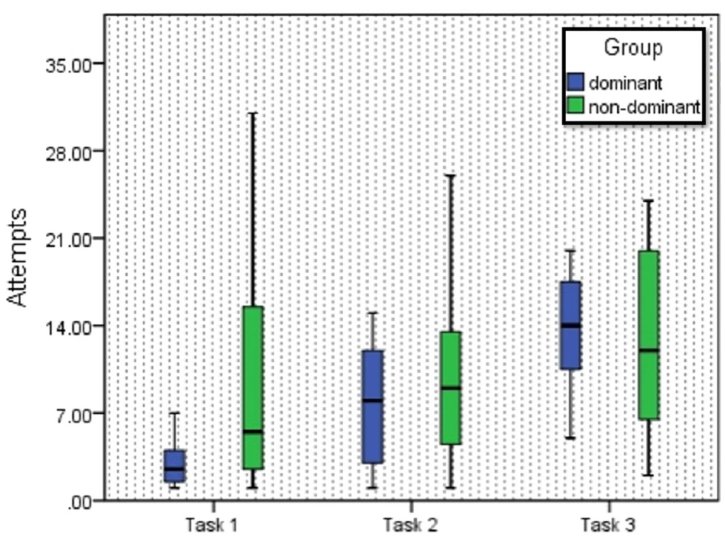
Additionally, it was explored if there is any effect on the participants considering aspects such as gender (male or female), the experience with virtual reality (none or little) and the handedness (left or right hand) in the tasks within the virtual reality environment. The results obtained showed that there is no significant effect between these aspects, and the data obtained show that between left and right-handers the time of Task 3 is at p<.10 (F1,14=6.637, p=.022) level, while the gender aspect in Task 1 (F1,14=3.62, p=.078) at p<.10 level.
Conclusions
This work has evaluated the effects of user experience (player and video game aspects) in a virtual reality environment under a proposed model. The effects of handedness on player and video game aspects with user experience scales were analyzed. Based on 3 different tasks (n = 16), it was found that the model led to high levels of engagement, enjoyment, motivation, and usability in the proposed virtual reality environment.
Likewise, no significant differences were found between the dominant and non-dominant groups in terms of handedness in the case study. Similarly, it was found that the time and attempts were similar among the three tasks. This leads us to consider future virtual reality environments with a context that allows the incorporation of tasks with a higher level of complexity and analyze their effects. These evaluations provide design elements for new virtual reality environments oriented to different contexts such as education, medicine, training, among others. In these environments the tasks to be performed by the user are an important aspect and can improve their experience within the virtual environment.
As future work, we propose the incorporation of aspects that allow expanding the user’s experience in a personal way within virtual reality environments, including tasks with a degree of specialization, such as writing, drawing in contexts according to the user’s needs in which the user’s experience can also be measured and thus establish improvements in virtual environments. Moreover, we plan to include a greater variety of users with diverse profiles that allows a more thorough investigation of their preferences. In addition, we plan to extend the proposed model to incorporate reinforcement learning algorithms, consider aspects of the video game such as audio, content, and strategies so that the elements within the virtual reality environments can automatically adapt to users to improve their satisfaction and avoid negative results or emotions.